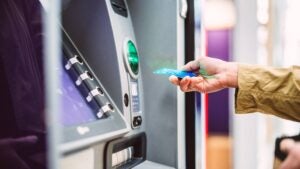Survey: ATM fees hit record high for third straight year while average overdraft fee dips

Cash may no longer be king these days, thanks to the convenience of electronic payments, although you might occasionally want some bucks to slip into a birthday card or tip a driver. Accessing your money keeps getting more expensive, however, if you’re using out-of-network ATMs. In fact, the average total ATM fees hit $4.86 in 2025 — up from $4.77 last year — according to Bankrate’s latest Checking Account and ATM Fee Study.
Another common bank fee is the overdraft fee, which banks often charge when they cover transactions that would otherwise bring a customer’s account to a negative balance. This fee is imposed by 94 percent of accounts, and the average amount has dipped 1 percent this year to $26.77, Bankrate found.
Meanwhile, it may be getting harder to avoid monthly service fees for consumers with an interest-earning checking account. The average minimum balance to avoid such a fee has climbed to $10,705, which is up nearly 5 percent from last year.
Those who opt for a non-interest checking account instead will have an easy time finding one that doesn’t charge fees. Nearly half (47 percent) of all non-interest accounts don’t charge monthly service fees, while another 48 percent of non-interest accounts will waive the fee if customers sign up for direct deposit.
Key insights from Bankrate’s 2025 Checking Account and ATM Fee Study
-
- ATM fees are at a record high. The average total cost of using an out-of-network ATM is now $4.86. It consists of the average surcharge of $3.22 levied by ATM-operating banks, plus the average fee of $1.64 from one’s own bank for using an ATM outside its network.
-
- Overdraft fees are down ever-so-slightly. After increasing the previous year, the average overdraft fee has dipped 1 percent this year to $26.77. Meanwhile, the average nonsufficient funds (NSF) fee has fallen for the 4th straight year to a new record low of $16.82.
-
- For interest checking accounts, the average minimum balance required to avoid service fees has reached a record high. The average monthly fee for interest checking accounts is now $15.65, with the average minimum balance to avoid this fee being $10,705 — up nearly 5 percent over last year.
-
- Free checking accounts remain highly accessible. Similar to last year, 47 percent of non-interest checking accounts charge no monthly service fees, while another 48 percent waive the fee for account holders who set up direct deposit.
-
- Atlanta remains the metropolitan area with the highest ATM fees. The average out-of-network ATM fee in Atlanta is $5.37. Like in 2024, Atlanta has the highest average fee for non-network ATM use, among those metro areas covered in Bankrate’s survey.
ATM fees hit record high for third straight year
One or two charges could result each time you use an ATM that’s not in your bank’s network. First, the bank that owns the ATM will likely assess a surcharge, and second, your own bank may charge you for going outside its network.
ATM-owner surcharges continue to climb: The average ATM surcharge has increased for the fourth straight year, hitting a record high of $3.22, up from $3.19 last year.
All the ATM-owning banks in the survey said they charge non-account-holders to use their ATMs, and none reduced the fee over the past year.
The average out-of-network ATM fee is the highest since 2018: The average fee you’ll pay your bank for going outside its ATM network is $1.64. This is up from $1.58 last year and the highest amount over the past seven years.
Per the survey, in 39 percent of cases, banks or specific accounts do not charge customers for out-of-network withdrawals. Among those that do charge a fee, however, increases in the amount eclipsed decreases by an 8-to-1 margin this year.
Combined ATM charges hit a record high: Together, the total average cost of using an out-of-network ATM is now $4.86, which is up nearly 2 percent from $4.77 last year and hitting a record high for the third consecutive year.
As ATMs become less frequently used, associated fees are likely to rise. Consumers can most easily avoid these fees by banking with institutions offering wide ATM networks or reimbursing out-of-network ATM charges. An increasing number of online banks and brokerages now reimburse ATM fees, regardless of the machine used.— Stephen Kates, CFP® | Bankrate Financial Analyst
ATM fees highest in Atlanta, lowest in Boston
Just like last year, Atlanta is where you’ll find the highest combined average ATM fees — an average of $5.37 — among the 25 metropolitan areas surveyed by Bankrate. In fact, Atlanta has seen the highest average combined fees for the past several years, ranging between $5.33 and $5.38 since 2022.
Other metro areas with high fees include Phoenix and San Diego, with average combined ATM fees of $5.35 and $5.31, respectively. Among areas covered in the survey, Seattle and Boston have the lowest average combined fees, of $4.42 and $4.37, respectively.
| Rank | Metro area | Average total ATM fee |
| 1 | Atlanta | $5.37 |
| 2 | Phoenix | $5.35 |
| 3 | San Diego | $5.31 |
| 4 | Detroit | $5.25 |
| 5 | Cleveland | $5.21 |
| 6 | Miami | $5.11 |
| 7 | Tampa | $5.05 |
| 8 (tie) | Los Angeles | $4.99 |
| 8 (tie) | San Francisco | $4.99 |
| 10 (tie) | Pittsburgh | $4.98 |
| 10 (tie) | Cincinnati | $4.98 |
| 12 | Milwaukee | $4.96 |
| 13 | St. Louis | $4.95 |
| 14 | Houston | $4.93 |
| 15 | Chicago | $4.85 |
| 16 | Denver | $4.81 |
| 17 | Dallas | $4.73 |
| 18 | New York | $4.72 |
| 19 | Kansas City | $4.70 |
| 20 (tie) | Washington, D.C. | $4.56 |
| 20 (tie) | Baltimore | $4.56 |
| 22 | Minneapolis | $4.45 |
| 23 | Philadelphia | $4.43 |
| 24 | Seattle | $4.42 |
| 25 | Boston | $4.37 |
Source: Bankrate’s 2025 Checking Account and ATM Fee Study.
Overdraft, NSF fees down ever so slightly
When a bank’s customer initiates a transaction that would otherwise bring the account to a negative balance, the bank can react in a number of ways. It might choose to cover the transaction and charge the customer an overdraft fee. Or, it might choose to deny the transaction and charge the customer a nonsufficient funds (NSF) fee.
Average overdraft fee is down, although 9 in 10 accounts still charge this fee: The average overdraft fee has dipped 1 percent, from $27.08 last year to $26.77 this year. While the average is down slightly, 94 percent of accounts Bankrate surveyed still charge this fee when they make a payment despite the customer not having enough money in the account.
A rule created in 2024 by the Consumer Financial Protection Bureau (CFPB) would have scaled back overdraft fees by providing banks with multiple options, including charging a per-overdraft fee that doesn’t exceed $5. The rule would have gone into effect in October 2025, although it has since been overturned by President Donald Trump and Congress by way of the Congressional Review Act.
Average NSF fee declines for fourth straight year: NSF fees are charged when the account holder doesn’t have enough available balance to cover a transaction — yet in this case, the bank declines the transaction instead of paying it. This year, the average NSF fee has fallen to a new record low of $16.82, while the number of accounts charging this fee has also reached a new low of 61 percent.
“Although overdraft and nonsufficient funds fees are declining slightly, their impact on consumers remains unchanged,” Bankrate’s Kates says. “Unfortunately, these fees disproportionately penalize consumers who are already managing extremely tight balances. Carefully tracking account balances or linking a secondary account to cover overdrafts will provide greater protection for consumers’ financial health than simply waiting for fees to decline further.”
Most banks don’t offer early direct deposit: If money is tight or you’re trying to avoid overdrafts, you may find early direct deposit proves useful. However, only 22 percent of banks surveyed said they provide two-day early access to direct deposit funds, up slightly from 21 percent last year.
Interest checking: Hefty balance requirements and scant returns
Nearly 9 in 10 interest checking accounts in Bankrate’s survey charge monthly service fees, with this year’s average fee increasing to $15.65, which is up from $15.45 last year. In fact, this year’s average fee is the third-highest on record, and fee increases among banks beat decreases by more than 3 to 1.
Many accounts waive the monthly service fee for those who maintain a set minimum balance, although that requirement can be steep, with the average now at a record high of $10,705 — up nearly 5 percent from last year’s $10,211 average.
Despite the often-high monthly fees and hurdles to clear for fee waivers, the average annual percentage yield (APY) on interest checking accounts is a scant 0.07 percent. While a better alternative for earning interest is often top high-yield savings accounts, the best high-yield checking accounts earn competitive APYs, make it easy to avoid fees and have low (or no) minimum deposit requirements.
Non-interest checking: Service fees easy to avoid
Free checking accounts are those that don’t charge monthly service fees. In 2025, nearly half (47 percent) of all non-interest checking accounts surveyed are free, which is similar to what Bankrate found in recent years’ surveys. An additional 48 percent of non-interest accounts will waive a monthly fee based solely on your signing up for direct deposit.
Altogether, 95 percent of non-interest accounts are free or can become free just by signing up for direct deposit.
Among non-interest checking accounts that do charge monthly fees, the average amount is $5.47 in 2025, which remains unchanged from last year. The average balance required to avoid the fee is $496, which is nearly the same as last year and considerably lower than the average balance requirement for interest checking accounts.
“Review the qualifying requirements for reducing or removing fees on interest-bearing checking accounts,” Kates says. “While balance requirements may be high at many banks, alternatives often include setting up direct deposit, using your debit card frequently, or linking other accounts. Don’t settle for paying a fee when many banks offer options for a fee-free account.”
For many consumers, a free checking account is a convenient place to keep money for bills and living expenses, while some also use a high-yield savings account to earn a competitive rate on money saved for emergencies or other short-term goals.
Ways to avoid bank fees
ATM fees
You can withdraw your cash without being hit with ATM fees in the following ways:
-
Use a bank with a large ATM network: If you use ATMs frequently, you could pay a pretty penny in fees over time if there isn’t an in-network ATM nearby. Find a bank that provides free access to plenty of ATMs near your home or work. Banks with large ATM networks include:
- Capital One: 70,000+ ATMs from Capital One and the MoneyPass and Allpoint networks
- Citibank: More than 60,000 ATMs from Citibank and the MoneyPass network
- Discover Bank: 60,000+ ATMs in the MoneyPass and Allpoint networks
- PNC Bank: More than 60,000 ATMs from PNC Bank and the MoneyPass and Allpoint networks
- Bank of America: 15,000 ATMs
- Chase Bank: 15,000 ATMs
- Get cash back from debit card purchases: Receive cash back at the register when using your debit card at participating retailers. There’s generally no fee associated with this, although there are likely to be much lower withdrawal limits than at an ATM.
- Find a bank that reimburses ATM surcharges: Some banks will reimburse ATM fees imposed by other banks when you use their ATMs.
Overdraft fees
While some banks have curbed their overdraft and NSF fees, the majority of banks still charge them. Depending on where you bank, you may be charged $34 or more for an overdraft. Ways to avoid these fees include:
- Opt out of overdrafts. You can tell the bank not to cover overdrafts, in which case you won’t be charged the associated fee. However, it’s important to note that the bank will then likely deny transactions that would have overdrawn your account.
- Set up overdraft protection: Many banks offer overdraft protection, which automatically transfers money from a linked savings account when a transaction would otherwise overdraw your checking account. Note that some banks charge a fee for these transfers.
- Set up low balance alerts: Many bank apps can alert you when your balance dips below a certain threshold. This can help you avoid overspending and being charged the associated fee.
Monthly service fees
Whether they earn interest or not, some checking accounts charge monthly service fees. When this is the case, you’ll often have to maintain a set minimum balance for the fee to be waived. Some tips for avoiding the monthly service fee include:
- Find an account with no monthly fees: It’s not difficult to find a free checking account that doesn’t charge monthly maintenance fees. You’ll commonly find such accounts from online-only banks, which tend not to charge many fees in general.
- Make sure monthly service fees are easy to avoid: If an account does charge a service fee, make sure it’s easy to avoid. One way banks often waive the fee is for customers who set up a regular direct deposit to the account.
Why we ask for feedback Your feedback helps us improve our content and services. It takes less than a minute to complete.
Your responses are anonymous and will only be used for improving our website.






